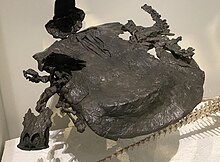| Henodus Temporal range: Late Triassic,
| |
|---|---|

| |
| Skeleton of Henodus at the American Museum of Natural History | |
| Scientific classification | |
| Domain: | Eukaryota |
| Kingdom: | Animalia |
| Phylum: | Chordata |
| Class: | Reptilia |
| Superorder: | †Sauropterygia |
| Order: | †Placodontia |
| Family: | †Henodontidae |
| Genus: | †Henodus Huene, 1936 |
| Species: | †H. chelyops
|
| Binomial name | |
| †Henodus chelyops Huene, 1936
| |
Henodus (from Greek: ἑνός henós, 'one' and Greek: ὀδούς odoús, 'tooth') is an extinct placodont of the Late Triassic period during the early Carnian age. Fossils of Henodus chelyops were found in the Estherienschichten Member of the Grabfeld Formation, near Tübingen, Germany.[1] It was around 1 metre (3.3 ft) in length. The single species within the genus is H. chelyops.[2][3]
Henodus is the only placodont thus far found in non-marine deposits, suggesting it may have lived in brackish or freshwater lagoons.
- ^ "Fossilworks: Gateway to the Paleobiology Database". www.fossilworks.org. Retrieved 25 January 2022.
- ^ Henodus chelyops, ein neuer placodontier. - Sonder-Abduck aus Palaeontographica Beiträge zur Naturgeschichte der Vorzeit, Abteilung A 84:99-148. - F. von Huene - 1936.
- ^ Der Dritte Henodus ergänzungen zur Kenntnis des Placodontiers Henodus chelyops Huene. - Sonder-Abdruck aus Palaeontographica Beiträge zur Naturgeschichte der Vorzeit, Abteilung A 89:105-114. - F. von Huene - 1938.